

The Bilen (also variously transcribed as Blin, and also formerly known as the Bogo, Bogos or North Agaw) are a Cushitic ethnic group in the Horn of Africa. They are primarily concentrated in central Eritrea, in and around the city of Keren and further south toward Asmara, the nation's capital. They were formerly known as the Bogo or North Agaw.
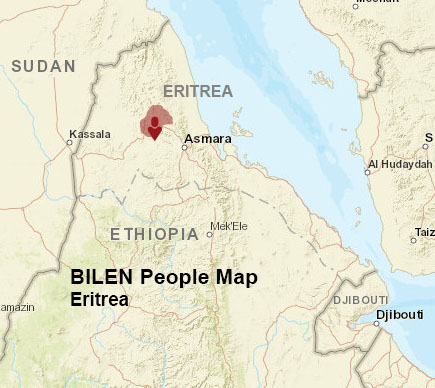

The meaning of the word 'Bilin' also is not known. Some version of the tradition holds that it is Saho word (belen) for Christian. In fact, 'Belen' in Saho means a Christian. (Kiflemariam Hamdé, 'Absmará yunivarsiti, p.3)
The Blin first entered Eritrea from Ethiopia during the sixteenth century primarily agriculturalists, they number about 96,000 and represent around 2.1% of Eritrea's population. About fifty percent of their population are Christian, primarily Catholic, while the other fifty percent are 20th century converts to Sunni Islam.
Keren is the second largest city in Eritrea, lying northwest of Asmara. It is the capital of the Anseba
province and home of the Bilen tribe. As of 2005, the population of this city has been estimated to be
86,483.The city is integrated with different types of tribes; Blin and Tigre are the dominant. It has two
High schools, St. Joseph and Keren Secondary School. Its climate is semi-desert hot during summary
and cold during winter. It is one of the fast growing cities in the country.
Bilen traditional society is organised into kinship groups. The women are known for their brightly coloured clothes and their gold, silver or copper nose-rings which indicate their social status.
In 1859, the Bilen numbered about 8,400. A 2009 government publication reports that the Bilen numbered about 65,518, or about 2.1 percent of country’s 3,119,920 total population. A 2022 estimate puts the Bilen at 186,278, about 3 percent of the country’s population of 6,209,262.
The Bilen speak a Central Cushitic language (often called Bilen or Belen) closely related to the Xamtanga (also called Xamir or Xamta) speaking sub-group of the Agaw people living in the Amhara state of northern Ethiopia.
The Bilen consider themselves descendants of a small migrant group that left the Lasta area of Ethiopia sometime in the 1530s. Prior to their incorporation into the Italian colony of Eritrea, the Bilen were governed by a hereditary chief who commanded the loyalty of lineage heads and community elders.
When studied by Munzinger from 1855-1858, Bilen represented Ethiopia’s northernmost frontier territory. Bilen community leaders and family heads interacted with nomadic herder communities living in surrounding lowland areas, many of whom of Tigre origin labored for well-off Bilen families as indebted laborers or captive servants.
Formerly, when the Bilen were primarily transhumance pastoralists, the most common type of dwelling at the main village was a flat-roofed stone house. When in seasonal camps the Bilen used palm-mat tents.
When studied by Munzinger in the late 1850s, the Bilen were primarily transhumant pastoralists with permanent villages in relatively cool locations, such as in and around Keren, and seasonal camps near good pasturage. Cattle were the principal domestic animal, but herds also included goats, donkeys and some horses. Munzinger deemed agriculture “relatively unimportant” to the Bilen, while acknowledging that they grew barley, maize, beans, and cabbage.
Town-dwelling Bilen are small shop owners or traders. The latter primarily sell produce, grain and livestock to both local consumers and middlemen from other areas.
Bilen women weave artistic palm-mats and grass baskets. Other crafts include leather sandals (medas), iron tools and silver ornaments.
Long-distance trade—generally involving cattle and to a lesser extent, slaves—was mostly with communities along the Red Sea coast.
Herding cattle and goats was exclusively a male activity. Boys provided assisted in tending calves and goats. In most households, male Tigre servants milked cows and assisted in related masculine tasks. Women and girls fetched water and wood, prepared food, and performed other domestic chores. Able-bodied girls helped their mothers by grinding grain. Elders engaged in community affairs, including presiding over ceremonies, resolving disputes, and negotiating inter-community relations.
Members of each patrilineage collectively held their main settlement and designated seasonal pastures. As the Bilen became increasingly sedentary, individual household heads came to own agricultural land by being the first to bring that land under cultivation. The Bilen had customary mechanisms for the transfer of privately-owned farmland and livestock through sale, inheritance and gift.
The Bilen were patrilineal and patrilocal. Localized, exogamous patrilineages displayed strong cooperation during a number of situations. For example, lineage members avenged the murder of fellow members, contributed money for communal rituals, and mutually supported each other during funerals and weddings. In addition to exogamous marriage ties, members of different patrilineages were related through a web of mutually-beneficial social ties.
Bilen kinship terms appear very descriptive and often ambiguous. Outside the nuclear family, terms used to refer to a specific person can be used to refer to other relatives both on the father’s and mother’s line.
The most common mode of marriage was parent-arranged. Most children were betrothed when infants, in some cases while still in the mother’s womb. The primary goal of marriage was the establishment of bonds between families; the parents did not bother to consult the children, much less ask for their consent.
The groom’s father paid a bride-price of three cows, three calves, some grain and unspecified amount of cash. Although permitted, polygyny was rare. Bilen custom also allowed both remarriage and widow inheritance by the deceased’s brother or, in some cases, son.
The most common residential unit was the nuclear family. In the rare case when a man had more than one wife, each had her own house.
The eldest son inherited all his father’s private property, including his cultivated plots, livestock, house, and tools. As guardian of the household, the heir was responsible for helping younger brothers and other dependent members.
In Sharkin and its environs the following items are subject to inheritance: house, title, debt, the fiancée or the wife of a dead person. But items such as woods, grazing lands and water holes belong to the community and are not inheritable.
Although most of the time inheritance is conducted without recourse to will and testament, there are instances where will and testaments is demanded. The reason why wills and testament is not needed is because the legal heirs are most of the time known before hand. However, the most common and acceptable way of transferring property is through written will.
When a husband dies, the first person in the line of inheritance is the wife. Next come the children, and in the absence of issue, his brothers become the heirs. In the event that he has no brothers, the estate goes to his cousins. If the husband has no issue, then the wife is entitled to all his property provided that she does not remarry. However, if she intends to remarry, she has to leave all the property to her children. If a person who losses his wife wants to remarry, he has firs to hand over the share of the deceased wife and her jewelry to the children.
Although girls are often deprived of their rights of inheritance, unmarried girls are entitled to an equal share along with their brothers. As in the rest of the Eritrean ethnic groups, the sharing of inheritance is made after the commemoration feast for the dead person is held. At times, the sharing of inheritance may get prolonged in the event that the heirs are too young to benefit from it.
Traditional Bilen society consisted of three major social classes: ruling elites (descendants of chiefly families and influential elders), commoners (members of local Bilen lineages), and non-Bilen outsiders (mostly enslaved persons and indebted Tigre laborers).
The Bilen governance system consisted of a hereditary chief, a council of elders, and local lineage heads. Bilen chiefs used to pay tribute to the Emperors of Ethiopia, who considered Bilen their northernmost frontier district.
Bilen customary law provided effective mechanisms for settling conflicts, including blood feuds, marital disputes and competing property claims. Conflicts between closely-related parties usually were resolved very quickly, while those involving strangers and neighboring ethnic groups often grew into violent confrontations.
Internal warfare was rare, as the Bilen were closely related to one another in multiple ways, including through webs of kinship ties and generations of reciprocal marriages.
The Bilen practice both Islam and Christianity. Muslim adherents mainly inhabit rural areas and have intermingled with the adjacent Tigre, while Christian Bilen tend to reside in urban areas and have intermingled with the Biher-Tigrinya. Sunni Islam is the most adhered religion among the Bilin (about 65% being Muslim) followed by Christianity of various denominations, and a few practice their traditional faith. The religious diversity of the Bilin has and is currently been peacefully coexisting for much time with little conflict arising out of religious differences.
Major life-cycle events were marked by ceremonies, such as the birth of first child, marriage, and the death of a family member. While these ceremonies varied in size and details, they all provided opportunities for displaying mutual aid and cooperation among closely-related families and lineage members.
In addition to a rich tradition of music, dance, and storytelling, Bilen arts include distinctively colored adornments, ornaments and hairstyles. Women also use eye makeup (kohl) and adorn their hands and legs with homemade henna.
Bilen women take smoke baths by putting sprigs of medicinal and fragrant plants on a fire. Smoke bathing supposedly heals minor illnesses while also providing hygienic and aesthetic benefits.
In common with other Muslims and Christians, the Bilen believe in an afterlife where the faithful followers of Allah or God shall be rewarded with eternal life in paradise. The corpse is ceremonially washed, perfumed, clothed, prayed over, and finally buried in a designated site. Graves of individuals are marked with stones. Family members commonly memorialized the deceased with annual commemorative feasts and periodic visits to the grave.
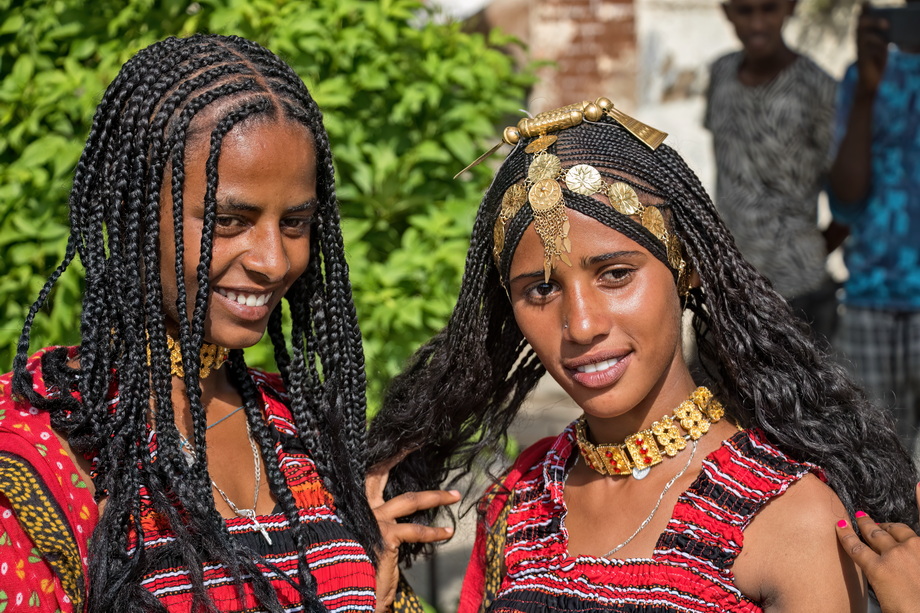
The most common cereal among this ethnic group is millet. This cereal is ground by women on millstones and the flour into kitcha, ga’at (thick porridge eaten with ghee), taita and hanza. Some cereals are eaten boiled. Most of the utensils used in the preparation of this food items are homemade.
The Bilen use diary products as their staple food, specializing in curd. This is because most of the members of this ethnic group are farmers raising livestock. Shiro is also one of the usually prepared dishes. Meat is eaten especially during holidays such as negdet (anniversary of patron saints), Easter, New Year, etc. and in some rare occasions when cattle are about to die for one reason or another they are slaughtered for meat. This is common practice among most of the nine Eritrean ethnic groups.
The members of the Bilen ethnic group consume a good amount of fruits and vegetables and use nug and sesame oils for cooking their food. Besides, the Bilen are great users of spices and condiments such as garlic, onion, mustard, pepper, etc. They also consume a large amount of wild fruits. The members of this ethnic group are also experts at preserving food, which are commonly used for long ravels. Some of these are roasted peanuts, tamarind, ground flaxseed, roasted wheat or barely, etc.
There is a specially prepared food known as beshelat which can be kept for a whole year. Its preparation is as follows: the dregs of surwa are made to boil and is then mixed with flour. The mixture is then poured on a mat and left to dry in the sun. Once dried, it is put in a container and sealed. It then can be eaten as porridge any time one feels like it. Roasted peanuts can be kept for long and do not need elaborate preparation.
Once grace is said, the children take their respective seats and wait for morsels of bread (which have been blessed by elder) to be handed out to them. Forbidden are drinking water while eating, eating from someone else’s side and taking a big morsel.
After every one is satiated, the eldest child goes around with bowl and a tin-can full of water helping the rest to wash their hands. The whole ceremony ends with a prayer.
The members of this ethnic group use various kinds of drinks such as debob, massa and berzi. Among these, debob is the most commonly used which is used in wedding feats, holidays, commemoration for the dead, celebration of patron saints, etc. It is said to be that debob can keep unspoiled up to four months. In addition to the above-mentioned beverages, other modern ones such as areki, local wine and sweet syrup are used.
The Bilen being generally followers of Islam and Catholicism, the diet they follow during lent or religious festival vary accordingly.
The people of Sharkin and its surrounding live in fixed villages. These members of the Bilen ethnic group are expected to leave space for streets when they build their houses. The width of the street should be large enough to allow yoked oxen and four pallbearers and the final decision for construction is given by the village elders. Old houses without owners are transferred to other people through a decision reached by village elders.
Only those who are ready to get married and establish families are given land to construct houses. Women and strangers do not have rights to land.
Among this ethic group, the commonest type of dwelling house is the augudo. However, some rich people are seen to build merebas. And at times it is common to see young spouses and less often long married couples living in agnets as temporary shelters.
As for agdos built by the members of this ethnic group, there is a strong similarity between the ones built in the highlands and those built by the Bilen. The only difference is in the household goods, furniture and facilities used. For example, the inside walls of the Bilen augudo is draped with a mat known as higag. A curtain known as litamet and a long veil to hide the bed known as aleget are also used.
Among the members of this ethnic group, the houses are constructed through village cooperation. The person whose house is being built by the village volunteer task force is expected to provide the workers with food, drink and tobacco. However, not all the houses are built in this manner, because after all the rich have the means to build their houses through professional masons.
At present, the trend is to build merebas, and here and there, cement, lime, chiseled stones are making their gradual introduction. The walls are nowadays built a bit higher than the past. The old traditional houses had only doors and no windows. But now not only windows are in use but doors are being made of woods crafted by professional carpenters.
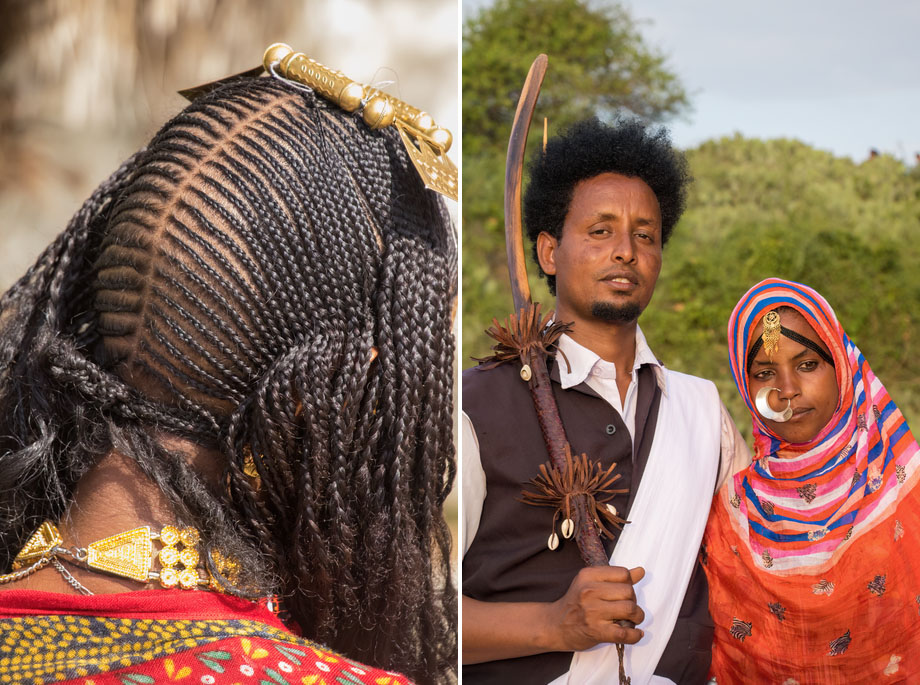
Footwear has been used irrespective of age or sex from early times among the members of this ethnic group. Before the coming of the Italians, a leather sandal known as medas was very common. This was crafted by the local people themselves.
At present, members of this ethnic group wear shoes of all types irrespective of age and sex, but most are fabricated by professionals. The use of rubber soles is also becoming popular, and modern shoes are making their entry in small towns.
In Sharkin and its environs, there are various types of ornament made by professionals for male and female customers. An unmarried girl puts an earring made of silver (and of gold if she is from rich family) called telal, and bracelets. If she is married, she puts four in each ear, and she puts a gold ornament (known as Sardat) on her forehead. Women who cannot afford silver or gold use beads instead.
Men sometimes use silver leg bands and silver earring, especially during the initiation ceremony. During mourning, a wife is expected to get rid of all her ornament and stays like that for a period of two years. If a wife during mourning gives birth to a child, she puts an imitation ornament made of palm leaves.
Children belonging to the Bilen ethnic group shave their heads and leave a small tuff of their hair on the crown of the head until they start to walk. For male children, this tuff of hair remains with them till the age of 10. Afterwards they have their heads shaved and during the initiation ceremony they wear their hair in Afro-style. When women grew old, they are expected to shave of their heads or have their hair plaited without ornament.
During mourning, some adult males are seen with their heads shaved off. As for widows, they are expected to shave their heads completely. Hairdressing is done by relatives and friends among the Bilen, and no professionals are set aside for such jobs.
Bilen women put ointment in their eyes before applying kohl. For fashioning long and loose strands of hair with wet-look, Bilen women apply butter mixed with powder made of roasted durrah or plain earth to the strands. In addition, they apply henna to their hands and legs. Among this ethnic group, males do sometimes apply butter to their hair.
Whenever one thinks about Eritrea, the immediate thing that comes to one’s mind is the existing strong harmony and coexistence among the nine ethnic groups of the country. Mutual respect and tolerance are deeply rooted in the Eritrean society which in turn serves as pillar for the present firm unity and nationalism – an asset rarely found in other countries. All these noble values of mutual respect and harmony symbolize the cherished slogan of unity in diversity. Despite the prevailing unity among all ethnic groups, each nationality is endowed with its own rich culture and tradition that distinguish the country as a multicultural nation.
The spectacular pattern of living, customs, dressing style and other ritual ceremonies of each ethnic group are also some of the decisive factors for tourism attraction.
In this first article of a continuing series about Eritrean cultures and customs, we will try to explore the rich culture of the Bilen ethnic group. Members of the Bilen ethnic group are commonly found in the Anseba region, particularly south-central part of the country, in and around Keren town and south toward Asmara. Primarily agriculturalists, this ethnic group represent about 2.1% of Eritrea's population. Bilen is also the name of their language.

Among this ethnic group, engagement is a family’s affair. The future spouses have no say whatsoever in their future married life. If for some reason two lovers get married without prior permission from their respective parents, the boy is obliged to pay a certain sum of money plus an ox to the girl’s father.
The marriage candidate has to fulfill the following requirements:
Same religion, close blood relationship (in Moslem society), no blood relationship whatsoever up to seven generations (in Christian society), beauty, riches and health.
In engagement, the father of the boy has nothing to offer to the father of the girl. In fact it is the latter who is expected to give a cow or an ox to the former. Among this ethnic group, the boy and the girl are promised for engagement by their respective families while still in their mother’s wombs. On the third day of the engagement, the mother of the betrothed girl prepares boiled legume and distributes it among the villagers in the hope that her grandchildren might multiply like the sands of the sea.
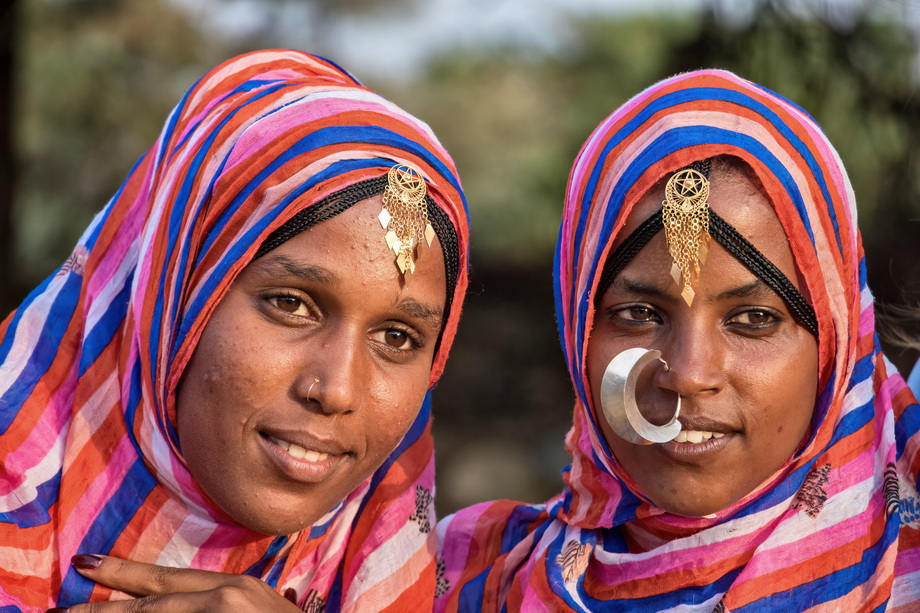
Among the Bilen ethnic group, the honeymoon may go on for two to three months on end. During these months, the bride enjoys visits from friends and relatives. The process continues until the time that the bride returns to her family or Melesot.
12 days after the wedding ceremony, the groom goes down to a stream with his friends, to wash himself and his clothes. The bride remains in her room and has her hair plaited and her eyes shadowed with Kohli.
40 days after the wedding day, the groom ceremoniously puts down the sword which he had carried since the marriage ceremony for fear that the evil spirits may not whisk him away.
The “disarming” ceremony heralds the termination of the function held by the best man in the house of the couple. He goes off to his daily work and so does the groom. During the honeymoon period, the bride is not allowed to sit at the same table with her husband. She takes her meals with her sister in-law and she eats frugally. The groom, who sits with his friends at the table, has no inhibition regarding the way he eats.
Since the bride is confined to her room all through the honeymoon period, she is obliged to relieve herself in a special pot provided for the occasion. Furthermore, she is not permitted to call out for someone in a loud voice and is therefore provided with a bell. Among this ethnic group, a lot of money and energy is spent on honeymooning. Fortunately, there are always all sorts of relatives to foot the bill.
The Bilen ethnic group also follow other types of marriage that are out of the norm, namely Mer’a Hayam, Mer’a Chiluk, etc. When the honeymoon is over and life returns to normal once more, the couple continues to stay with the groom’s family. However, the eagerness of the groom to attend to his own affairs by himself and the continuous disagreement between the bride and her mother in-law may shorten the couple’s stay with the family and so they pack up and go to live in a separate place on their own. On the other hand, if the groom feels that he has no enough agricultural tools to start a decent life all by himself and if the bride and the mother in-law get along fine together, the couple may prolong their stay with the family.
As the soon as the couple have their own house, the role they play in the society shows some changes. Now they are full members of the society and enjoy all the rights and privileges in the village. Nonetheless, the woman remains unequal to the man. In a patriarchal and male dominated society like that of the Bilen, the husband is the only breadwinner and can do whatever he likes with the property. He can buy and sell as he pleases and everything in the house is under his control. The woman on the other hand is confined to the kitchen and bearing children. If she is given some work like poultry to tend or taking care of some household goods, it is because such activities may seem degrading for a man to even pay attention to.
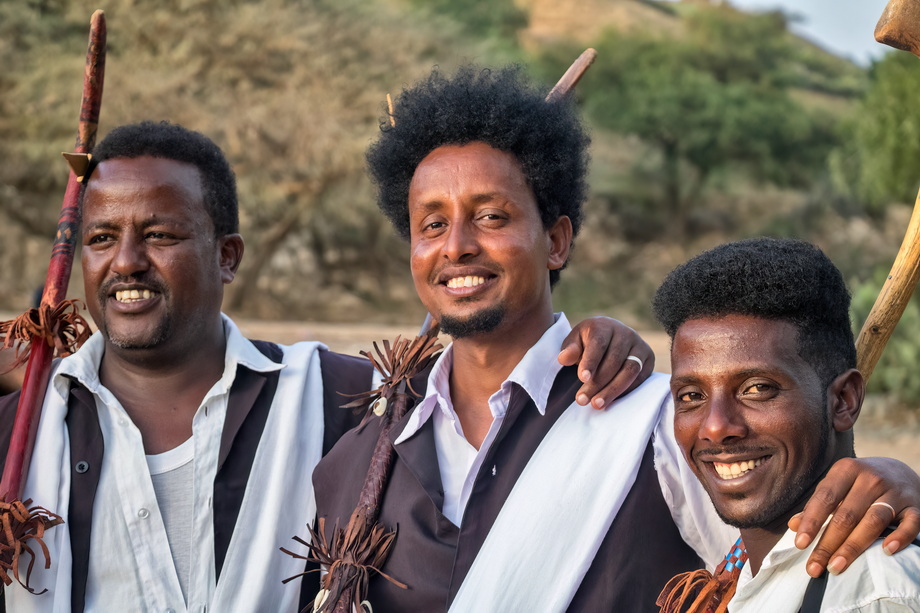
As in all other Eritrean ethnic groups, the Bilen show special traditional attitude towards pregnant women. If the woman is in full term, she is not allowed to perform heavy duty works such as grinding corn, carrying heavy loads, etc. She uses a lot of ointment and takes smoke baths frequently. She eats fatty foods and wears warm clothes. The pregnant woman refrains from going funerals and from attending big gatherings. The idea is to protect her from the hustle and jostle of a crowd.
When the time for her to give birth arrives, the pregnant woman goes to her parent’s house provided she is giving birth for the first time. If the labor pangs take more time than normal, prayers are said on her behalf. If however the labor pain continues, the whole village supplicates God for mercy.
At present, consulting the doctor in such case is becoming common. When a child is born, the umbilical cord is immediately cut with a sharp razor. Next, the midwife breathes in the infant’s ears and nostrils and then washes it with warm water.
If the newly born child is male, the whole household rejoices with exceeding gladness, for a male is the unquestioned heir of the family. That’s why they ululate seven times for a male and only three times for a female.
The neighborhood who come to the feast after hearing the ululation are served coffee and porridge and visitors arrive carrying coffee beans, milk, flour, butter, etc. Eight days after giving birth, the woman is allowed to go out of her house for a walk, but only after the ceremony of stepping over burning firewood. The child’s head is then shaved by the father who leaves a small tuft of hair on the skull above the forehead.
This is followed by another ceremony which includes the washing of the women’s laundry by the neighborhood women. After the end of the wash day, the women are invited for coffee and porridge at the house of the woman who gave birth.
There are several reasons for couples to get divorced in the Bilin ethnic group. Some of them are listed below:
Since the Bilen are mostly Catholics, divorce is very difficult to implement. It is therefore customary among this ethnic group that in the event that it is the man who is asking for divorce, he has only to leave the house. The wife remains in the house with all the couple’s properties under her care. On the other hand, if it is the wife who is asking for divorce, she has only to leave the house without much ado. But if divorce is wanted by both parties, the properties are divided equally between them.
Smoke bath is very common among the female members of this ethnic group, especially among married women. They do it for hygienic and aesthetic reasons. Smoke bath is not always without its inconveniences and requires patience and great endurance to physical pain (as the heated smoke that is produced from the not completely dried twigs and leaves does sometimes burn the sensitive skin of the orifices and cause pain). Nevertheless, whether they like it or not, married women are expected by tradition to undergo the treatment until the ‘old’ skin is peeled off and a new yellowish and ‘beautiful’ one is grown instead.
Sources: